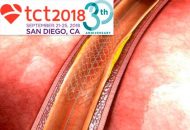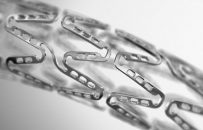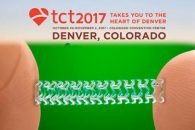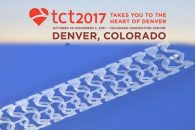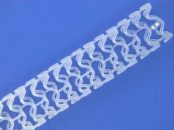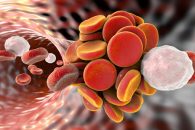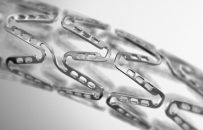A new sirolimus-eluting bioresorbable scaffold with far thinner struts resulted non inferior to the Xience as to the end point of angiographic in-segment late loss (LL) powered for noninferiority testing. Even though this is a small study with angiographic end points, it might be the first step towards the return of bioresorbable scaffolds. Read also:…
TCT 2018 | ABSORB IV: Much Life Left for Bioresorbable Scaffolds
Previous studies have documented higher rates of adverse events with bioresorbable scaffolds (ABSORB) compared with metallic drug-eluting stents (DES). However, these studies included lesions smaller than recommended for these scaffolds and a suboptimal implantation technique. The ABSORB IV study, presented by Dr. Stone at TCT 2018 and published simultaneously in The Lancet, randomized patients to polymeric everolimus-eluting scaffold Absorb…
More Bad News on Bioresorbable Scaffolds
A year after the implantation of everolimus-eluting bioresorbable scaffold Absorb 1.1, optical coherence tomography (OCT) scans showed neointima formation covering plaque without significant luminal loss. At 5 years, the device is supposed to disappear completely, potentially thrombogenic plaque components are supposed to be covered by endothelium, and the vasomotor function is supposed to be recovered. However, there…
ABSORB III: after 3 Years, the Bioresorbable Scaffold is Still a Disappointment
Courtesy of the SBHCI. The 3-year outcomes of the ABSORB III trial, which randomized 2008 patients 2:1 to an everolimus eluting bioresorbable scaffold (1322 patients) vs. a metallic stent with permanent everolimus eluting polymer (686 patients), was published with low profile and great disappointment. Primary end-point, a composite of target vessel failure, occurred in 13.4% of patients receiving…
Absorb IV: Bioresorbable Scaffolds with an Optimized Implantation Technique
Courtesy of the SBHCI. The Absorb IV trial randomized 2604 patients in a 1:1 ratio to receive an Absorb everolimus-eluting bioresorbable scaffold or a Xience stent. With the aim of minimizing the problems observed in previous studies, the Absorb IV protocol excluded small caliber (<2.5 mm) vessels and included mandatory aggressive pre-dilation followed by non-complacent balloon post-dilation. Patients could…
ABSORB II: No Benefits from Scaffolds After Complete Bioresorption
Courtesy of the SBHCI. The ABSORB II study sought to assess the mechanical properties of everolimus-eluting bioresorbable scaffolds, such as the increase in minimal lumen area and the recovery of the vasomotor properties of the treated artery. Last year saw the publishing of negative results for the primary endpoints, registering a higher rate of complications at…
These Are the Thrombosis Predictors for Absorb Bioresorbable Scaffolds
J Am Coll Cardiol Intv has recently published a special issue on bioresorbable scaffolds. Abbott’s decision to pull Absorb off the market probably prompted the fast publishing of all related articles sent to the journal. Bioresorbable scaffolds were developed in hopes that they would reduce the rates of events per year 1 year post-implantation by 1.5%-3%…
Very Late Thrombosis in Bioresorbable Scaffolds
The presence of a metallic device interrupts normal laminar flow and creates an artery environment that favors thrombosis, leaving the vessel vulnerable to very late thrombosis. Dual antiplatelet therapy, a better implantation technique, and several improvements in new drug-eluting stents (DES) (thinner struts, and higher polymer stability and biocompatibility) have lowered significantly the incidence of…
BVS: Controvertial Scaffold
Courtesy of Dr. Agustín Vecchia. The advent of resorbable vascular scaffolds (BVS) generated high expectations among interventionists because of its potential advantages over bare metal stents. However, when comparing BVS against the Xience stent, we observed an increased rate of events associated to the first device, to their detriment. Among the reasons behind this poor…
AIDA: bioresorbable scaffold thrombosis still a concern in studies
Courtesy of the SBHCI. This study presented at PCR and simultaneously published by NEJM still challenges the safety of bioresorbable scaffolds. This was a multicenter noninferiority work carried out in the Netherlands, comparing 1:1 everolimus-eluting bioresorbable scaffold ABSORB and permanent-polymer everolimus-eluting stent Xience. The primary endpoint was target-vessel failure (a composite of cardiac…
- 1
- 2

